Analysing Work and Organisation: Implementing Key Changes Report
VerifiedAdded on 2020/03/04
|7
|1254
|72
Report
AI Summary
This report provides a detailed analysis of work and organization, focusing on the impact of implementing lean principles and technological advancements on organizational structures. It explores key changes such as the reduction of hierarchical structures, the blurring of boundaries between roles, the importance of team building, and the rise of outsourcing. The report also addresses the challenges associated with organizational changes, including the absence of training, resistance to change, and improper implementation, as well as the critical roles of leadership and decision-making. It emphasizes the need for managers to envision the desired outcomes, define governance structures, engage stakeholders, identify supporters, and evaluate changes to ensure successful implementation. The report concludes by highlighting the significance of adapting to changes for organizational growth and goal achievement, supported by references to relevant academic research.
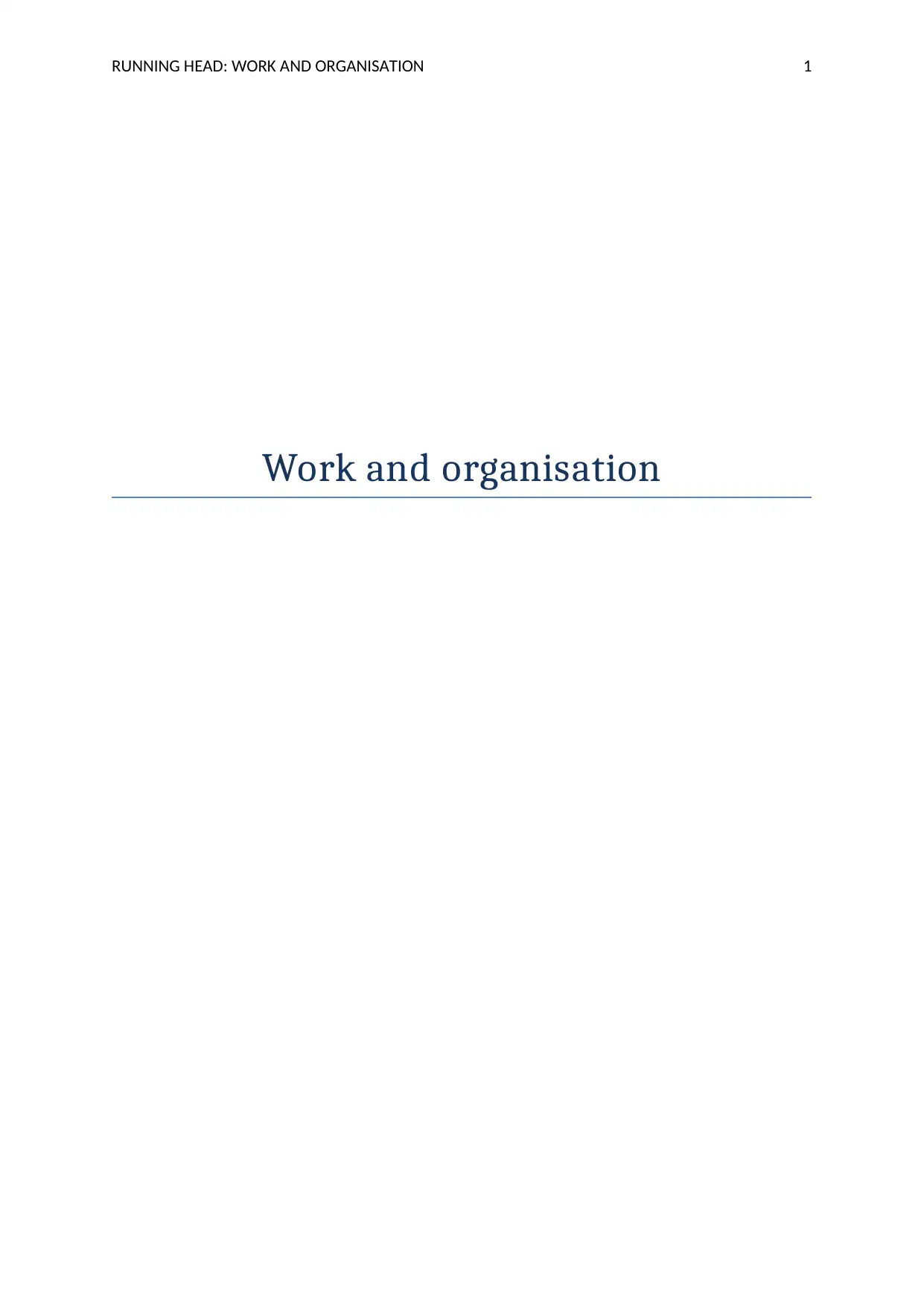
RUNNING HEAD: WORK AND ORGANISATION 1
Work and organisation
Work and organisation
Paraphrase This Document
Need a fresh take? Get an instant paraphrase of this document with our AI Paraphraser
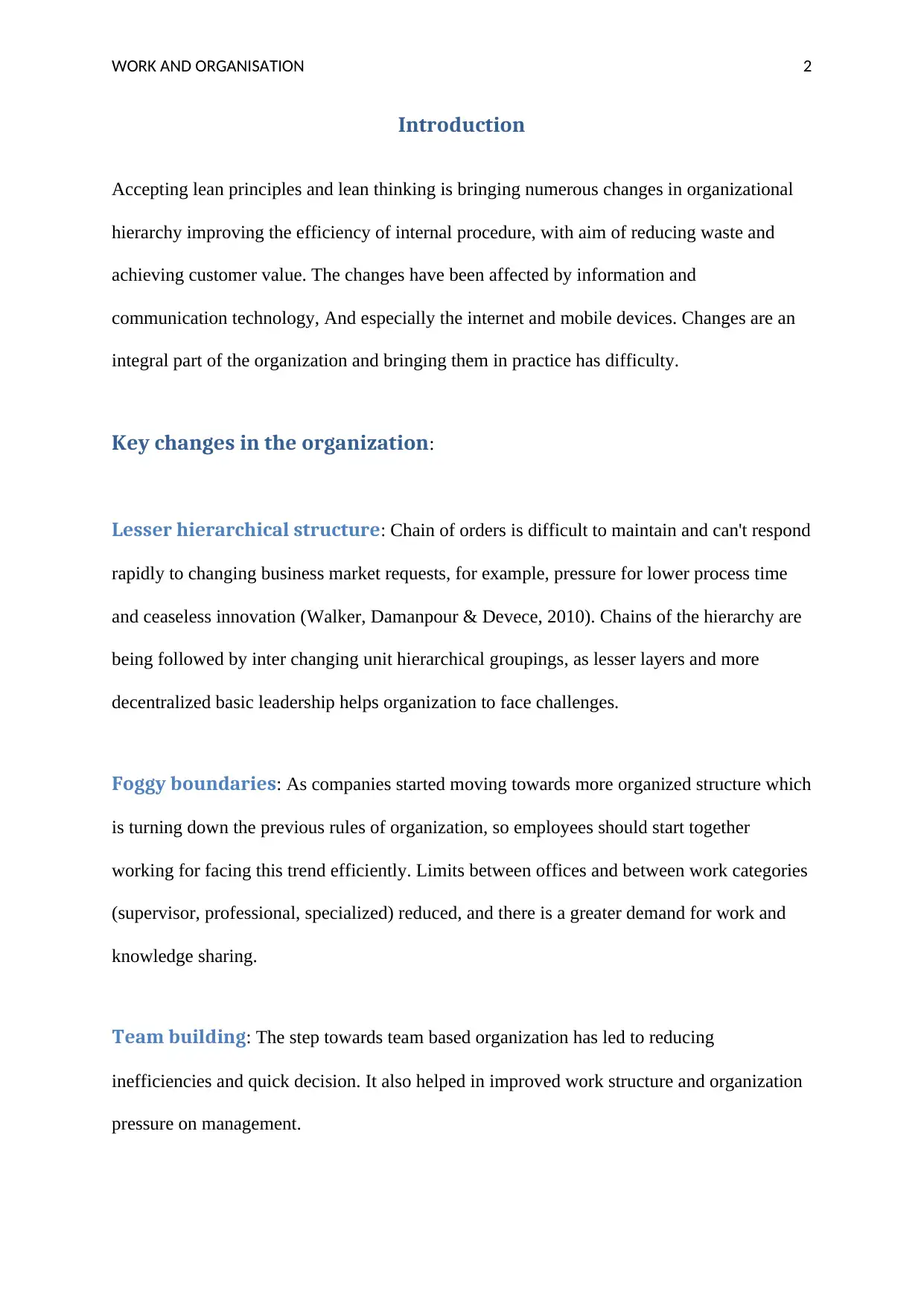
WORK AND ORGANISATION 2
Introduction
Accepting lean principles and lean thinking is bringing numerous changes in organizational
hierarchy improving the efficiency of internal procedure, with aim of reducing waste and
achieving customer value. The changes have been affected by information and
communication technology, And especially the internet and mobile devices. Changes are an
integral part of the organization and bringing them in practice has difficulty.
Key changes in the organization:
Lesser hierarchical structure: Chain of orders is difficult to maintain and can't respond
rapidly to changing business market requests, for example, pressure for lower process time
and ceaseless innovation (Walker, Damanpour & Devece, 2010). Chains of the hierarchy are
being followed by inter changing unit hierarchical groupings, as lesser layers and more
decentralized basic leadership helps organization to face challenges.
Foggy boundaries: As companies started moving towards more organized structure which
is turning down the previous rules of organization, so employees should start together
working for facing this trend efficiently. Limits between offices and between work categories
(supervisor, professional, specialized) reduced, and there is a greater demand for work and
knowledge sharing.
Team building: The step towards team based organization has led to reducing
inefficiencies and quick decision. It also helped in improved work structure and organization
pressure on management.
Introduction
Accepting lean principles and lean thinking is bringing numerous changes in organizational
hierarchy improving the efficiency of internal procedure, with aim of reducing waste and
achieving customer value. The changes have been affected by information and
communication technology, And especially the internet and mobile devices. Changes are an
integral part of the organization and bringing them in practice has difficulty.
Key changes in the organization:
Lesser hierarchical structure: Chain of orders is difficult to maintain and can't respond
rapidly to changing business market requests, for example, pressure for lower process time
and ceaseless innovation (Walker, Damanpour & Devece, 2010). Chains of the hierarchy are
being followed by inter changing unit hierarchical groupings, as lesser layers and more
decentralized basic leadership helps organization to face challenges.
Foggy boundaries: As companies started moving towards more organized structure which
is turning down the previous rules of organization, so employees should start together
working for facing this trend efficiently. Limits between offices and between work categories
(supervisor, professional, specialized) reduced, and there is a greater demand for work and
knowledge sharing.
Team building: The step towards team based organization has led to reducing
inefficiencies and quick decision. It also helped in improved work structure and organization
pressure on management.
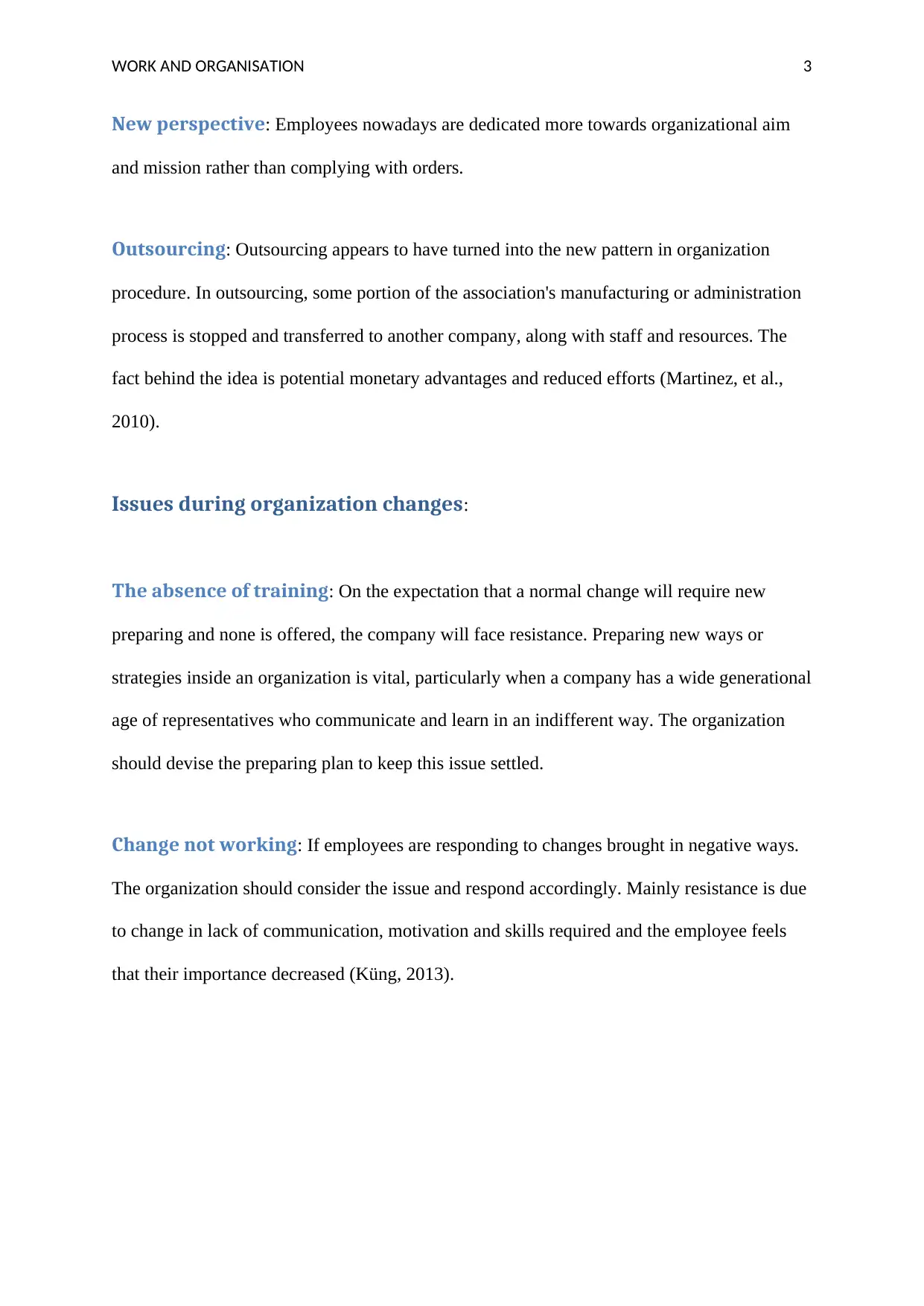
WORK AND ORGANISATION 3
New perspective: Employees nowadays are dedicated more towards organizational aim
and mission rather than complying with orders.
Outsourcing: Outsourcing appears to have turned into the new pattern in organization
procedure. In outsourcing, some portion of the association's manufacturing or administration
process is stopped and transferred to another company, along with staff and resources. The
fact behind the idea is potential monetary advantages and reduced efforts (Martinez, et al.,
2010).
Issues during organization changes:
The absence of training: On the expectation that a normal change will require new
preparing and none is offered, the company will face resistance. Preparing new ways or
strategies inside an organization is vital, particularly when a company has a wide generational
age of representatives who communicate and learn in an indifferent way. The organization
should devise the preparing plan to keep this issue settled.
Change not working: If employees are responding to changes brought in negative ways.
The organization should consider the issue and respond accordingly. Mainly resistance is due
to change in lack of communication, motivation and skills required and the employee feels
that their importance decreased (Küng, 2013).
New perspective: Employees nowadays are dedicated more towards organizational aim
and mission rather than complying with orders.
Outsourcing: Outsourcing appears to have turned into the new pattern in organization
procedure. In outsourcing, some portion of the association's manufacturing or administration
process is stopped and transferred to another company, along with staff and resources. The
fact behind the idea is potential monetary advantages and reduced efforts (Martinez, et al.,
2010).
Issues during organization changes:
The absence of training: On the expectation that a normal change will require new
preparing and none is offered, the company will face resistance. Preparing new ways or
strategies inside an organization is vital, particularly when a company has a wide generational
age of representatives who communicate and learn in an indifferent way. The organization
should devise the preparing plan to keep this issue settled.
Change not working: If employees are responding to changes brought in negative ways.
The organization should consider the issue and respond accordingly. Mainly resistance is due
to change in lack of communication, motivation and skills required and the employee feels
that their importance decreased (Küng, 2013).
⊘ This is a preview!⊘
Do you want full access?
Subscribe today to unlock all pages.

Trusted by 1+ million students worldwide
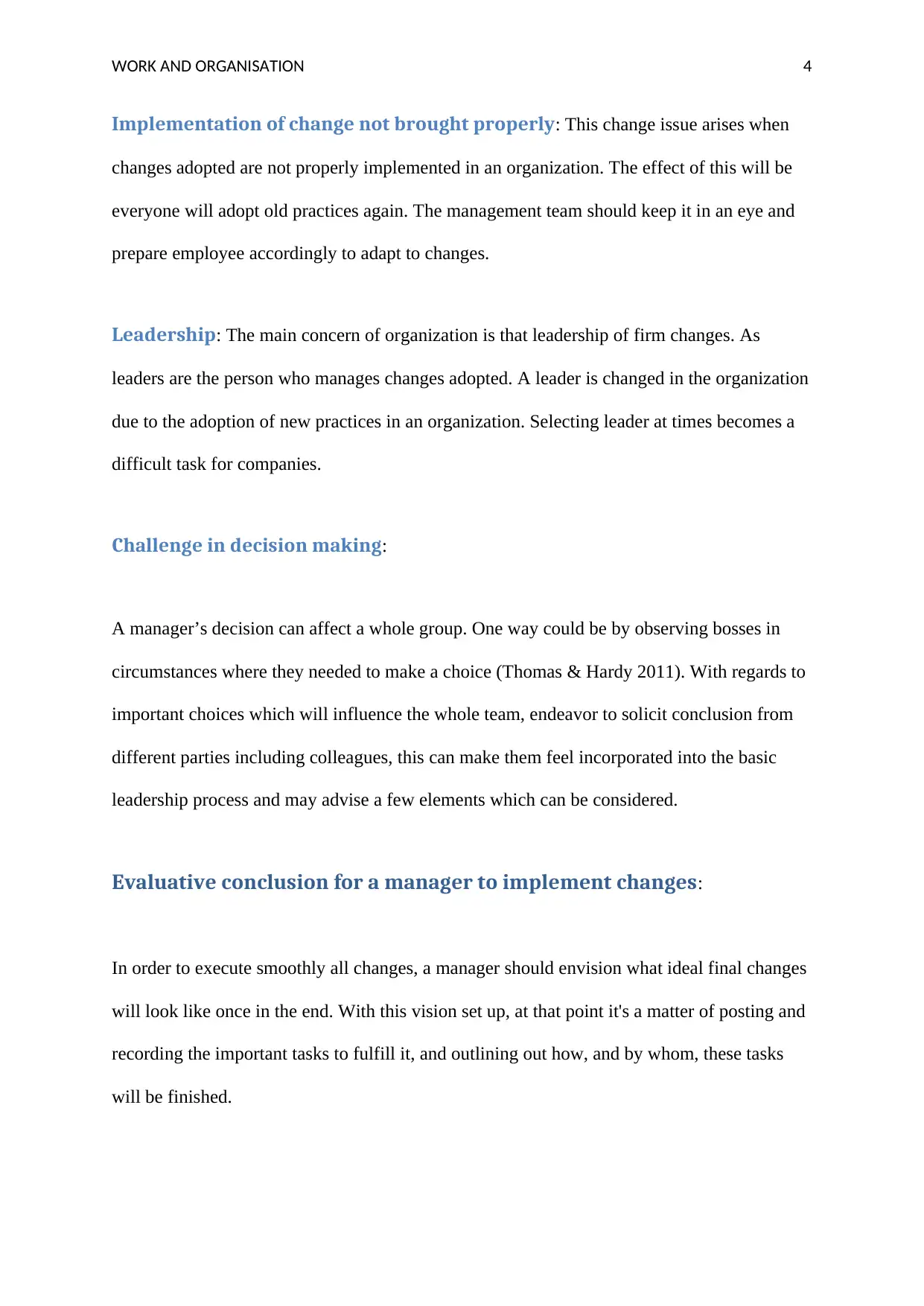
WORK AND ORGANISATION 4
Implementation of change not brought properly: This change issue arises when
changes adopted are not properly implemented in an organization. The effect of this will be
everyone will adopt old practices again. The management team should keep it in an eye and
prepare employee accordingly to adapt to changes.
Leadership: The main concern of organization is that leadership of firm changes. As
leaders are the person who manages changes adopted. A leader is changed in the organization
due to the adoption of new practices in an organization. Selecting leader at times becomes a
difficult task for companies.
Challenge in decision making:
A manager’s decision can affect a whole group. One way could be by observing bosses in
circumstances where they needed to make a choice (Thomas & Hardy 2011). With regards to
important choices which will influence the whole team, endeavor to solicit conclusion from
different parties including colleagues, this can make them feel incorporated into the basic
leadership process and may advise a few elements which can be considered.
Evaluative conclusion for a manager to implement changes:
In order to execute smoothly all changes, a manager should envision what ideal final changes
will look like once in the end. With this vision set up, at that point it's a matter of posting and
recording the important tasks to fulfill it, and outlining out how, and by whom, these tasks
will be finished.
Implementation of change not brought properly: This change issue arises when
changes adopted are not properly implemented in an organization. The effect of this will be
everyone will adopt old practices again. The management team should keep it in an eye and
prepare employee accordingly to adapt to changes.
Leadership: The main concern of organization is that leadership of firm changes. As
leaders are the person who manages changes adopted. A leader is changed in the organization
due to the adoption of new practices in an organization. Selecting leader at times becomes a
difficult task for companies.
Challenge in decision making:
A manager’s decision can affect a whole group. One way could be by observing bosses in
circumstances where they needed to make a choice (Thomas & Hardy 2011). With regards to
important choices which will influence the whole team, endeavor to solicit conclusion from
different parties including colleagues, this can make them feel incorporated into the basic
leadership process and may advise a few elements which can be considered.
Evaluative conclusion for a manager to implement changes:
In order to execute smoothly all changes, a manager should envision what ideal final changes
will look like once in the end. With this vision set up, at that point it's a matter of posting and
recording the important tasks to fulfill it, and outlining out how, and by whom, these tasks
will be finished.
Paraphrase This Document
Need a fresh take? Get an instant paraphrase of this document with our AI Paraphraser
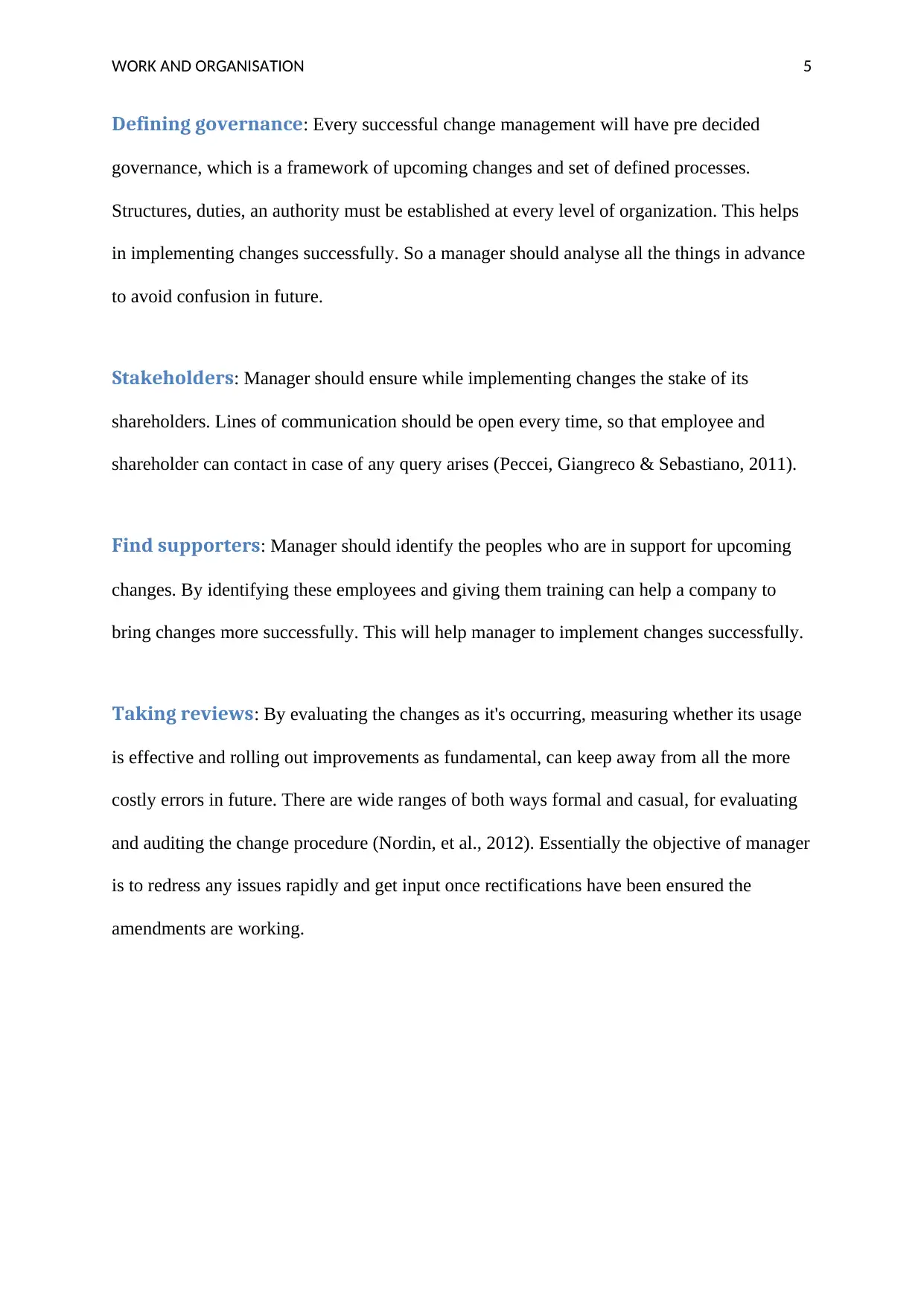
WORK AND ORGANISATION 5
Defining governance: Every successful change management will have pre decided
governance, which is a framework of upcoming changes and set of defined processes.
Structures, duties, an authority must be established at every level of organization. This helps
in implementing changes successfully. So a manager should analyse all the things in advance
to avoid confusion in future.
Stakeholders: Manager should ensure while implementing changes the stake of its
shareholders. Lines of communication should be open every time, so that employee and
shareholder can contact in case of any query arises (Peccei, Giangreco & Sebastiano, 2011).
Find supporters: Manager should identify the peoples who are in support for upcoming
changes. By identifying these employees and giving them training can help a company to
bring changes more successfully. This will help manager to implement changes successfully.
Taking reviews: By evaluating the changes as it's occurring, measuring whether its usage
is effective and rolling out improvements as fundamental, can keep away from all the more
costly errors in future. There are wide ranges of both ways formal and casual, for evaluating
and auditing the change procedure (Nordin, et al., 2012). Essentially the objective of manager
is to redress any issues rapidly and get input once rectifications have been ensured the
amendments are working.
Defining governance: Every successful change management will have pre decided
governance, which is a framework of upcoming changes and set of defined processes.
Structures, duties, an authority must be established at every level of organization. This helps
in implementing changes successfully. So a manager should analyse all the things in advance
to avoid confusion in future.
Stakeholders: Manager should ensure while implementing changes the stake of its
shareholders. Lines of communication should be open every time, so that employee and
shareholder can contact in case of any query arises (Peccei, Giangreco & Sebastiano, 2011).
Find supporters: Manager should identify the peoples who are in support for upcoming
changes. By identifying these employees and giving them training can help a company to
bring changes more successfully. This will help manager to implement changes successfully.
Taking reviews: By evaluating the changes as it's occurring, measuring whether its usage
is effective and rolling out improvements as fundamental, can keep away from all the more
costly errors in future. There are wide ranges of both ways formal and casual, for evaluating
and auditing the change procedure (Nordin, et al., 2012). Essentially the objective of manager
is to redress any issues rapidly and get input once rectifications have been ensured the
amendments are working.
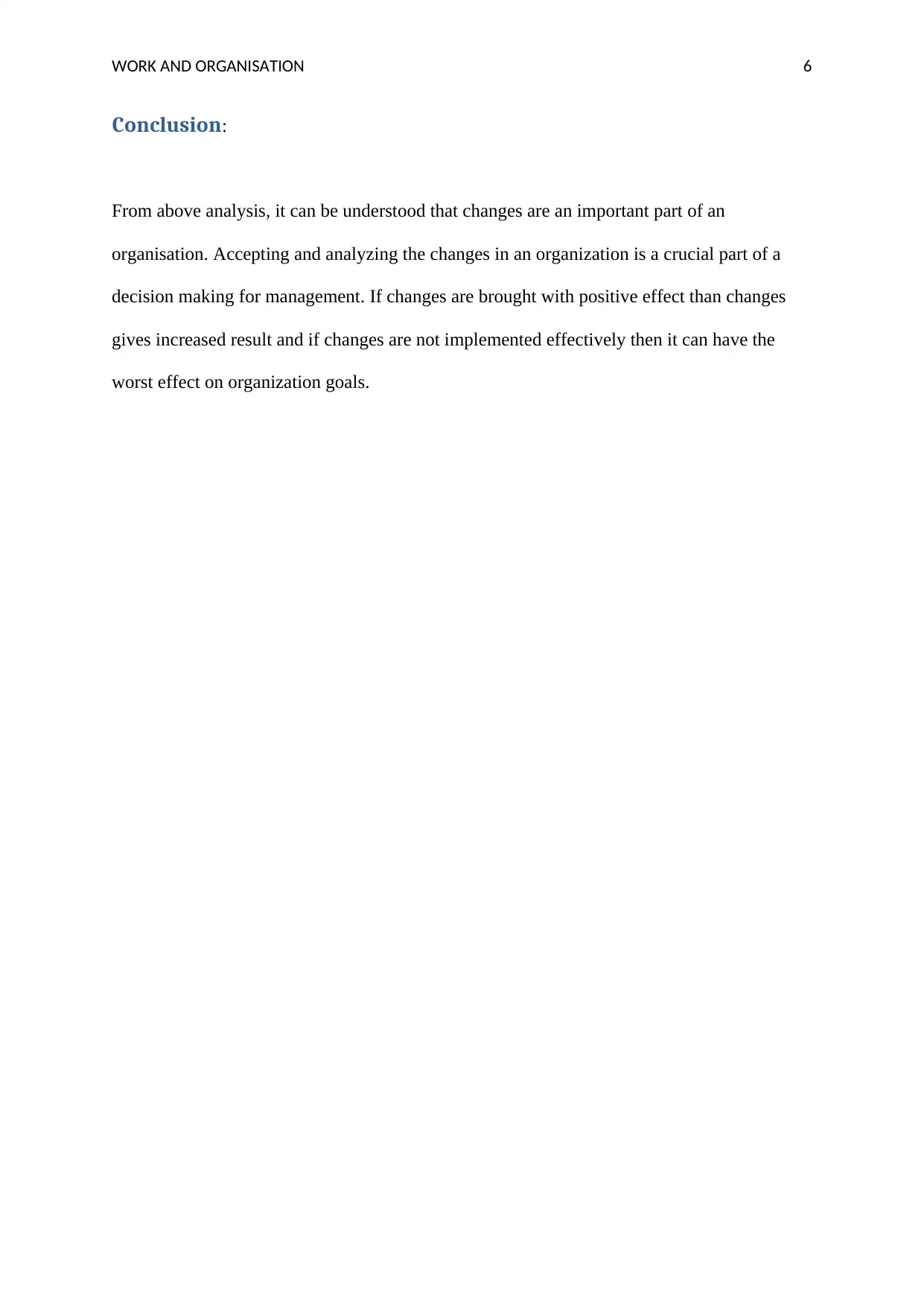
WORK AND ORGANISATION 6
Conclusion:
From above analysis, it can be understood that changes are an important part of an
organisation. Accepting and analyzing the changes in an organization is a crucial part of a
decision making for management. If changes are brought with positive effect than changes
gives increased result and if changes are not implemented effectively then it can have the
worst effect on organization goals.
Conclusion:
From above analysis, it can be understood that changes are an important part of an
organisation. Accepting and analyzing the changes in an organization is a crucial part of a
decision making for management. If changes are brought with positive effect than changes
gives increased result and if changes are not implemented effectively then it can have the
worst effect on organization goals.
⊘ This is a preview!⊘
Do you want full access?
Subscribe today to unlock all pages.

Trusted by 1+ million students worldwide
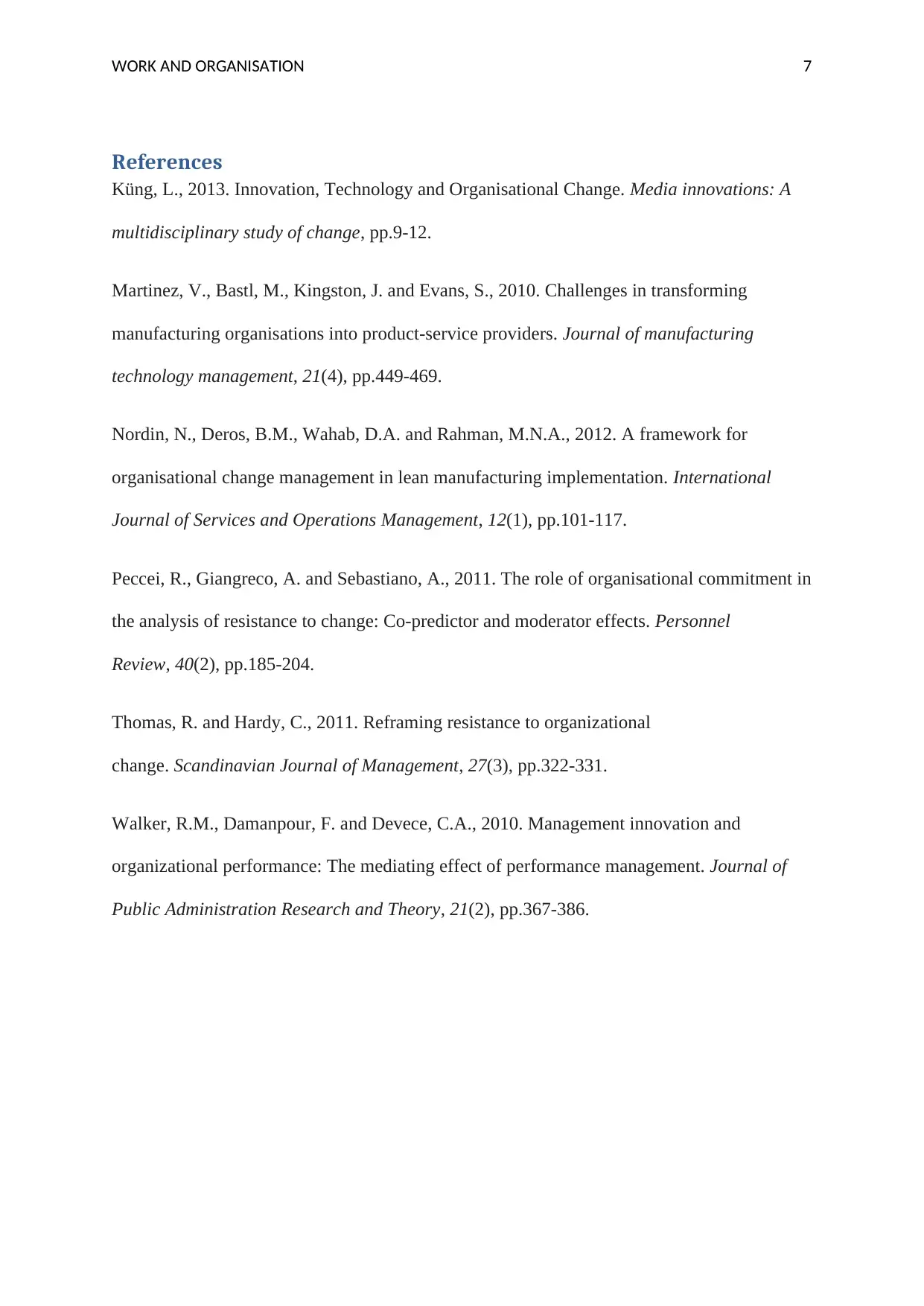
WORK AND ORGANISATION 7
References
Küng, L., 2013. Innovation, Technology and Organisational Change. Media innovations: A
multidisciplinary study of change, pp.9-12.
Martinez, V., Bastl, M., Kingston, J. and Evans, S., 2010. Challenges in transforming
manufacturing organisations into product-service providers. Journal of manufacturing
technology management, 21(4), pp.449-469.
Nordin, N., Deros, B.M., Wahab, D.A. and Rahman, M.N.A., 2012. A framework for
organisational change management in lean manufacturing implementation. International
Journal of Services and Operations Management, 12(1), pp.101-117.
Peccei, R., Giangreco, A. and Sebastiano, A., 2011. The role of organisational commitment in
the analysis of resistance to change: Co-predictor and moderator effects. Personnel
Review, 40(2), pp.185-204.
Thomas, R. and Hardy, C., 2011. Reframing resistance to organizational
change. Scandinavian Journal of Management, 27(3), pp.322-331.
Walker, R.M., Damanpour, F. and Devece, C.A., 2010. Management innovation and
organizational performance: The mediating effect of performance management. Journal of
Public Administration Research and Theory, 21(2), pp.367-386.
References
Küng, L., 2013. Innovation, Technology and Organisational Change. Media innovations: A
multidisciplinary study of change, pp.9-12.
Martinez, V., Bastl, M., Kingston, J. and Evans, S., 2010. Challenges in transforming
manufacturing organisations into product-service providers. Journal of manufacturing
technology management, 21(4), pp.449-469.
Nordin, N., Deros, B.M., Wahab, D.A. and Rahman, M.N.A., 2012. A framework for
organisational change management in lean manufacturing implementation. International
Journal of Services and Operations Management, 12(1), pp.101-117.
Peccei, R., Giangreco, A. and Sebastiano, A., 2011. The role of organisational commitment in
the analysis of resistance to change: Co-predictor and moderator effects. Personnel
Review, 40(2), pp.185-204.
Thomas, R. and Hardy, C., 2011. Reframing resistance to organizational
change. Scandinavian Journal of Management, 27(3), pp.322-331.
Walker, R.M., Damanpour, F. and Devece, C.A., 2010. Management innovation and
organizational performance: The mediating effect of performance management. Journal of
Public Administration Research and Theory, 21(2), pp.367-386.
1 out of 7
Related Documents
Your All-in-One AI-Powered Toolkit for Academic Success.
+13062052269
info@desklib.com
Available 24*7 on WhatsApp / Email
![[object Object]](/_next/static/media/star-bottom.7253800d.svg)
Unlock your academic potential
Copyright © 2020–2025 A2Z Services. All Rights Reserved. Developed and managed by ZUCOL.




